News

TRX 101: Twisted Strap?
So you've eagerly been anticipating the arrival of your new TRX Suspension Trainer, and when it arrives and you remove it from the box, you find the straps are twisted (like the images here). Want to make sure you're setting up your TRX correctly from day one? Take our quick assessment quiz for personalized setup guidance. Don't fret, dear TRXer. We've got a solution for this problem.
TAKE OUR TRAINING QUIZ
Our Customer Service Team receives this question from members of the TRX Community from time to time, and therefore, they have put together this helpful step-by-step visual guide on how to untwist your TRX (special shout out to Erik!).
If you've performed the steps recommended in the above PDF and your TRX strap is still twisted, then contact our Customer Service Team via phone at 888-878-5348 or email. No problem is too big or too small (or too twisted!) for them to help solve.

TRX 101: No Scraping
Do the straps of your TRX Suspension Trainer ever rub against your arms and shoulders when you’re doing a TRX Chest Press? Isn’t that annoying?
Here to help you correct the problem is TRX Head of Human Performance Chris Frankel and one of the personal trainers at Park Road Fitness in Burlingame, California.
You may recall the term "scraping" from an earlier blog post on the Six TRX Sins. Want to perfect your TRX form? Take our quick assessment quiz to get personalized technique tips and corrections.
TAKE OUR TRAINING QUIZ
Scraping tends to happen when doing a TRX Chest Press with your hands too low, causing the straps of the Suspension Trainer to rub across your arms and shoulders. This is problematic for two reasons:
When the straps are rubbing across your arms and shoulders, it's uncomfortable and annoying, distracting you from focusing on the movement and getting in a good set.
The more your arms and shoulders rub, the less this move is accomplishing its intended purpose (improving core stability). As you may remember from the stability principle, the more points of contact you have, the easier an exercise is going to be, and the less you will be relying on your core to maintain a plank position.
So, how do you fix it? First, simply move your hands up in relation to your shoulders. Come to the top of the press and move your hands up until the straps are no longer touching your arms and shoulders. Shoot for two to three inches off of your arms. That way, you can get through a full rep without touching.
If after making this adjustment, the straps are still rubbing your arms, try externally rotating your hands, aligning the straps more with the inside of your forearms, instead of rubbing across the top of them. If you try that and find the straps are still rubbing, move your feet farther from the anchor point until you can get more comfortable stabilizing from your core.
Are you experiencing any issues you think might be compromising the effectiveness of your TRX workout? Let us know below.
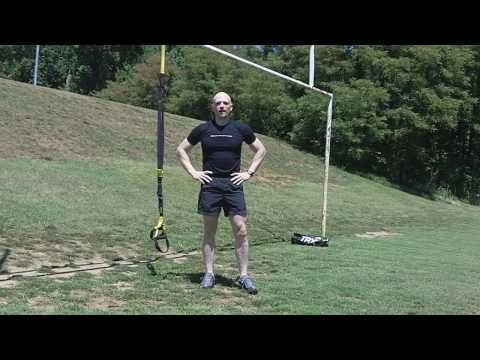
TRX 10/10/10 Workout Challenge
Designed by TRX Master Trainer Jonathan Ross, this new challenge is advanced and requires many characteristics of fitness to be present all at once. It requires strength, stability, balance, power, coordination and endurance.
Success in fitness is found in developing the various parts of fitness without allowing anyone to dominate to the exclusion of others. This challenge does just that by asking for challenging exercises to be performed with rapid transitions and all exercises requiring full body stability with localized strength and power.
Set up for the TRX 10/10/10 Challenge:
Perform 10 reps of three exercises as a circuit with 10 second transitions between exercises.
Rest for 60 seconds and switch the TRX foot during the rest.
Perform 10 reps of same three exercises with the other leg in TRX.
TRX Suspension Trainer Exercises (all in single handle mode):
TRX Inverted Shoulder Press
TRX Leg Extension
TRX Elevated Lunge
"Intense" TRX Inverted Shoulder PressThis is a challenging frontal plane upper body exercise requiring a combination of shoulder stability, mobility and strength. It is critical to differentiate this movement from a chest press by performing a “vertical push” motion like an overhead dumbbell press.
Criteria:
Torso must be parallel to arms, which are close to vertical.
Range of motion on lowering must bring top of head close to ground.
Training Tips:
Hold the inverted position statically to develop the strength and endurance of the stability in the shoulder. Maintaining the position takes strength initially but holding helps provide “stability endurance” that will be necessary to perform the exercise.
Next, work on strength and mobility by dropping the free foot to the floor and perform the shoulder press movement, keeping the torso parallel to the arms.
"Extreme" TRX Leg ExtensionRoss created this variation of a TRX Leg Extension to bring even more challenge to the quadriceps muscle for mobility and to the upper body and torso for stability. By having the feet significantly higher than the head, the leg extension must be performed “uphill” and thus the term “extreme”.
Criteria:
Head must be directly under anchor.
Thigh of free leg stays parallel to torso.
Range of motion on knee of TRX leg must be from just above ground to full extension
Training Tips:
From the standard leg extension position (feet under anchor), perform a leg extension from an elbow plank position. This lowers the upper body and provides more stability from the ground while creating more of an “uphill” push on the TRX leg.
Move head closer to anchor and perform the exercise from an elbow plank position, then progress to a hand plank position. Repeat as necessary to bring head under anchor.
"Explosive" TRX Elevated LungeThis is a classic TRX exercise performed with power, balance and coordination.
Criteria:
TRX foot must be directly under or in front of anchor.
Ground foot must completely leave the ground on each rep.
Training Tips:
Perform an elevated lunge slow and controlled with the foot, knees and hips aligned. At first, use little to no arm movement.
Gradually introduce arm movement in a gait-like pattern with the arms and legs moving in opposition. (i.e., when your ground leg is bent at the bottom position, your opposite arm is in front.)
Next, perform the exercise more rapidly progressing to where your heel gets light and lifts slightly, but the toes stay down. The next step is lift off!
What are you waiting for? Grab your TRX and get started. You’ve got all weekend to practice this one. And of course, if you feel you’ve earned bragging rights, share your score below. And be sure to challenge your friends to the TRX 10/10/10 Challenge.
Jonathan Ross, ACE Personal Trainer of the Year, Discovery Health Fitness Expert, TRX Master Trainer and creator of the TRX Super Hero workout, brings a fresh perspective on fitness to the industry (www.AionFitness.com). His personal experiences help him to create exercise strategies that deliver big results for clients.
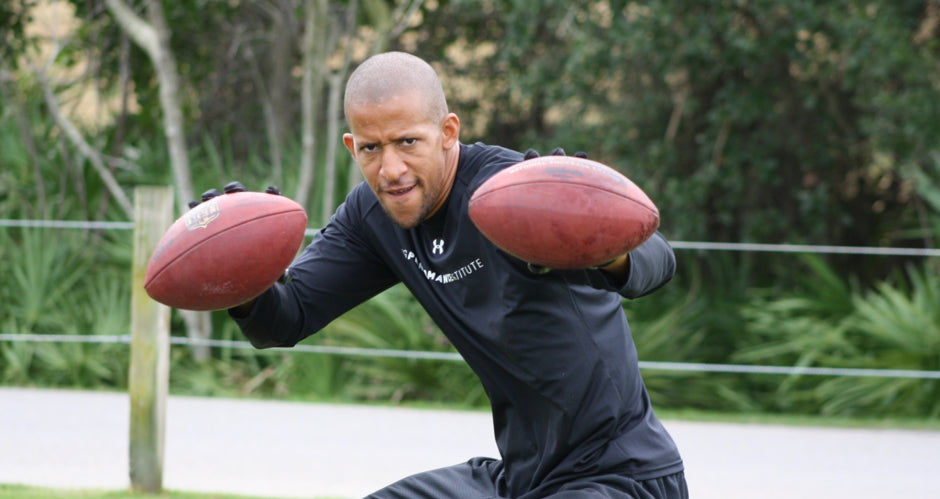
Train Like the Pros: Try This NFL Workout at Home
Everyone is working out at home these days, including professional football players. For the average fitness enthusiast, exercise may involve a video, like the free TRX LIVE workouts that launch each day on TRXTraining.com. For pro athletes, the routine may involve customized Zoom workouts. Curious about what those custom training sessions look like? We have some answers, thanks to TRX Master Trainer Trevor “TA” Anderson.
From the little leagues to the professional leagues, Anderson is a performance-boosting ninja. He’s a personal trainer, a multi-sport performance expert, and—lately—he’s been doing covert TRX ops, leading virtual workouts for professional athletes during stay-at-home orders.
What makes Anderson so good?
First, he’s played all sports. All of them. Football, soccer, baseball, basketball, slam ball—which he described as is “a weird extreme basketball sport played with trampolines on the ground.” Yes, Anderson is a gifted athlete, but his athletic background makes Anderson an even better trainer. The man is a legend among legends, training top-ranked professional athletes and Hall of Famers.
“Because I have a professional athletic background, I work with a lot of athletes, plus everyday folks: the seventh-grade kid who wants to make his lacrosse team, moms of three, and every kind of client in between,” he said. “TRX has helped me connect with every single one of those people in those populations. It's something common that I can share with every single one of them no matter what their level is.”
Traditionally, Anderson’s clients show up to work with him at Better Every Day, his gym and coaching business in Orlando. But due to the coronavirus pandemic, professional athletes have turned to TRX for guidance in their stay-at-home training programs. Anderson stepped in to help.
Given Anderson’s reputation for guiding top players to reach their potential, it’s natural to be curious about which exercises he programs in a Suspension Trainer session. Get the full workout posted below.
In this generation-defining moment, no one knows when we’ll be back to gyms, back to sports, back to sharing our lives within six feet of one another. While a workout may not seem like a big deal in the scope of what’s going on in the world, it’s a chance to do something for yourself, to prioritize your wellness and work toward a goal. Whether you do that with Anderson’s workout below or any of the free TRX LIVE workouts online, take this moment to prove just how strong you are.

Total-Body TRX Circuit from Fitnessista
TRX Training
TRX Training
Whether you’re a seasoned TRXpert or a novice to Suspension Training, this total-body TRX circuit from our friend at Fitnessista delivers an efficient and fun workout you can do anywhere.
The workout is intended to be done as a circuit, moving from exercise to exercise, with minimal rest. After you have finished all of the exercises, rest for a few minutes and repeat the whole circuit two to three times.
View the full workout on Fitnessista, here.
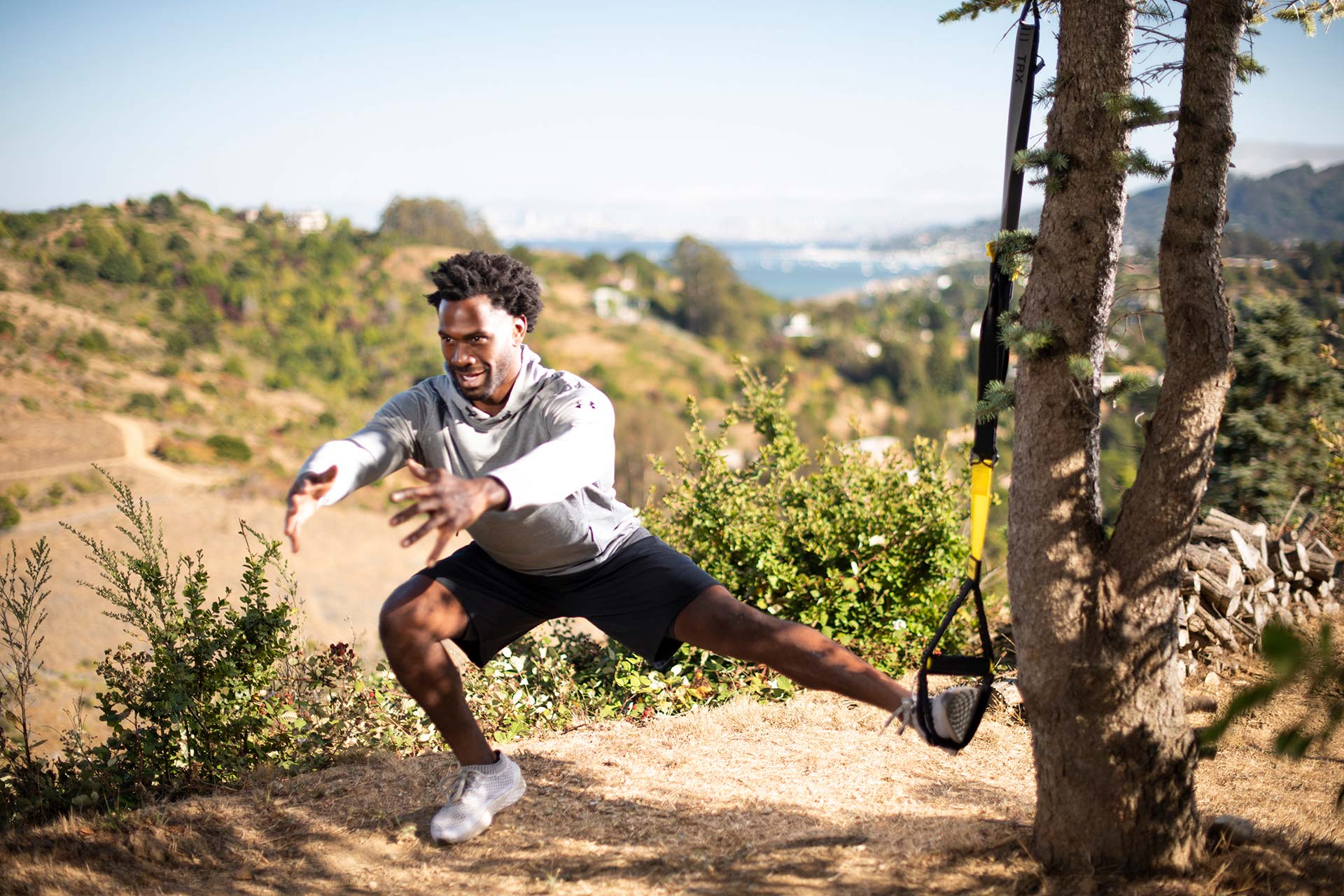
Train Anywhere With TRX and Fitbit
The leaves may be starting to turn but the great outdoors is still calling for you to explore. Good news—TRX has everything you need to power your fitness the whole way, no matter the destination, no matter how far you travel. In honor of our belief that fitness should fit your life, we’re excited to announce our partnership with Fitbit! Together, we’ll show you how easy it is to move, sweat, train (and track it all) on the go with your TRX Suspension Trainer.
Train and track on the go with the FitBit Versa 3™
We’ve teamed up with Fitbit to give you a full-body workout right from your wrist, no phone required. Use the TRX® Training Fitbit App on the Fitbit Versa 3™ to watch videos, haptics, get strap length direction, and more. The Versa 3 has all the usual bells and whistles, plus cool new features like built-in GPS to track pace and distance (hello, outdoor runs), Sleep Scores, Active Zone Minutes, and swim-proof materials for aquatic adventures.
Get routine
Always know exactly where you stand with your heart rate, daily steps, workouts, and more, all reported in real-time to help you build awareness of your fitness habits.
Get social
Share your stats or workouts on Instagram, Facebook, and anywhere else to give yourself a pat on the back (and encourage your friends to cheer you on).
Get motivated
Get the nudge you need to stay on track with personalized reminders that help you move more, stick to a sleep schedule, and more.
Work out anywhere, from parks to national forests
We all know how easy it is to get an effective, head-to-workout on our TRX Suspension Trainer. What you might not know is how easy it is to roll up and hang from anywhere. Here are some ideas on where you can anchor your Suspension Trainer:
Volleyball posts at your community hub
That beautiful birch tree on your hike
A kid’s jungle gym in the park
Chain-link fences that border a high school
Lifeguard stands at the beach
Set up in 4 steps
Because we want you to focus on your workout and nothing else, we designed the TRX Suspension Trainer to set up smoothly. Want to make sure you're setting up your TRX correctly? Take our quick assessment quiz to get personalized setup recommendations.
TAKE OUR TRAINING QUIZ
Find an anchor point (tree, post, etc) that your Suspension Anchor strap can fit around
Attach your Suspension Anchor strap 7-9 ft above the ground
Clip the carabiner to secure and attach your TRX Suspension Trainer
Make sure the black loops of the TRX Suspension Trainer hang 6 ft above the ground
Start working out!
Prefer a video? Here you go.
Sweat it out with the TRX App
Need a workout? No problem. The Official TRX App® gives you hundreds of workouts right at your fingertips, from HIIT to yoga to functional training, all guided by world-class coaches. It tracks and analyzes your data, plus reacts in real-time with customized training tips, motivation, and workout plans, all to help you achieve your goals faster.
Even when the road trips end and gyms eventually open back up, there’s one thing we know for sure: virtual training is here to stay. Stay tuned for more #TRXAnywhere tips & tricks (and stay on the lookout for an amazing virtual launch, coming soon).
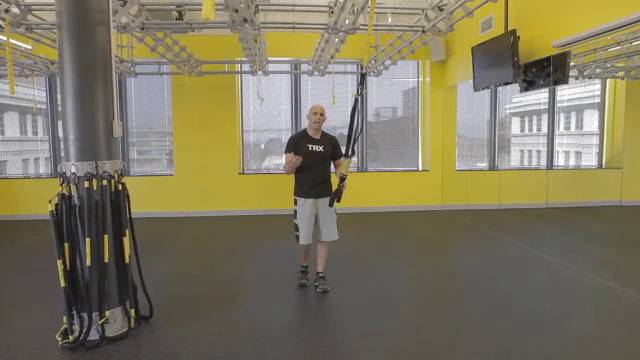
Top 3 Ways to Use A Suspension Trainer
There are many reasons the TRX Suspension Trainer is all you'll need for your complete home gym, but in this video, TRX Head of Human Performance Chris Frankel narrows it down to just three. Watch the video to see what Chris considers the top three reasons you need to be training your clients and athletes on the TRX.
The TRX is unparalleled when it comes to the following:
1) Core training.
Your center of gravity is located just above your hips along the midline of the body. Changing body positions shifts your center of gravity. The body uses muscular strength and coordination to control its center of gravity during movement. Suspension Training bodyweight exercise is designed to intentionally displace your center of gravity, activating the core musculature during every exercise to stabilize and balance the body in a truly functional way.
2) Pulling exercises.
It's one of the oldest bodybuilding methods, but it works big-time. Pulling exercises allow you to train all of the muscles involved in pulling (back, biceps, rear delts, traps, forearms, hamstrings) together at once, so you're really lighting up your entire posterior chain. With the TRX Suspension Trainer, you're pulling your entire bodyweight, plus you can add an exterior load if you want an additional challenge. The Suspension Trainer requires you to integrate the entire posterior chain with the pulling moves--hip extension combined with torso stability and pulling from the back. Hard to beat it!
3) Unilateral training.
Unilateral training is important to help identify muscle imbalances and/or weakness, which can lead to injury. Research has found that about 65 percent of injuries--both athletic and lifestyle-related--come from overuse, which is repetitive use of joints that are rendered dysfunctional by muscular imbalances. The simplest way to avoid muscle imbalance is to choose exercises that strengthen opposing muscle groups or perform unilateral training. Enter, the TRX Suspension Trainer.
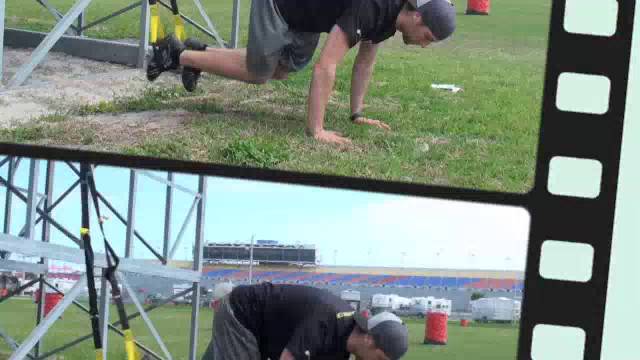
Three TRX Exercises For Motocross
At age six, pro motocross racer Johnny Lewis raced his first flat track on a Yamaha. Take our quick assessment quiz for a motocross-specific training plan. After that race, his dad knew it was time to get a faster bike.
TAKE OUR TRAINING QUIZ
Within 10 years, Johnny won hundreds of regional and national flat track races. After finishing his amateur career, Johnny made a jump to the pro circuit. It was during this time he discovered the TRX Suspension Trainer and began integrating it into his workouts. Two seasons later, Johnny had eight podiums and one pro career win under his belt.
"Straight off the bat, I realized the TRX is one of the best things I've ever used to build core strength," says Johnny. "The core is a big thing with motorcycle racing. You don't really ride a motorcycle with your hands; a lot of it is core, lower body. The more you hold on, the more you're fighting the bike. These bikes are designed to go pretty much by themselves. When people jump on and force them to do things, that when you get out of control."
This is a lesson Johnny learned the hard way. In a 2009 pro race in Las Vegas, Johnny and the race leader collided, resulting in a torn ACL for Johnny, which ended his season.
Johnny's sports medicine therapist had never heard of the TRX before, but his immediate reaction upon seeing it was "Wow" and with his blessing, Johnny started incorporating it into his rehabilitation. "With my knee, he didn't want me doing a squat wrong, but with the TRX, I was able to do the exercise with control and use the TRX to stabilize myself. It helped me to advance my rehab significantly. My therapist was amazed with how quickly I recovered, considering the extent of my injury. After he saw what it could do, he decided to order some TRXs for his clinic."
Johnny credits the TRX with not just fast-tracking his rehab but giving him a competitive advantage. In addition to the core stability gains he's made and maintained with the TRX, Johnny also relies on the TRX to develop balance, flexibility, durability and endurance, crucial when you consider his race season consists of approximately 20-22 rides in nine months. He works out on the TRX four to five days a week, interspersed with outdoor rides when the weather cooperates in his native Pennsylvania.
Without the aid of a trainer, Johnny relies on the information he finds on TRXtraining.com. "There's no reason to have a personal trainer," he says, "I just find new things on the site and come up with my own workout plan."
Johnny will be able to put his program design skills to use in his new endeavor, the recently formed Ride Academy for riders of all ages and all ability levels. "I want to provide young riders a place where they can learn everything and give these kids an edge." He hopes to introduce the TRX into the training mix at the Academy soon because he considers it the most effective tool any rider could use.
"I can make people almost cry on the TRX," says Johnny, "even the people who generally spend a lot of time in the gym. A few minutes on this thing, and they're whupped!"
With two second place finishes at Daytona, Florida’s “Bike Week” in mid March, Johnny's second pro flat track season if off with flying colors. "It was a great way to start the season off. I plan to keep the momentum building this year.”
Check out the video above to get a taste of Johnny's life, including the TRX moves he relies on (TRX Mountain Climber, TRX Mid Row and TRX Seated Figure-four Stretch) to keep him ready for race day.
Are you a motocross racer using the TRX in your training? Tell us about it below.

They Got It From Their Mamas
Fitness journeys are unique to each individual, but these four TRX Trainers say their moms set them on the path to careers in fitness. Niko Algieri and Jay Brockway Celebrity trainers and brothers Niko Algieri and Jay Brockway will tell you fitness is in their DNA. While known for their intense TRX classes at Equilibrium in London, Jay says their mother, Gillian Brockway, has been teaching group fitness for years. She even owns a gym in Wales: Merlins Bridge Boxing Club. “She teaches five nights a week: Insanity, Taebo, Keep Fit, Legs, Bums and Tums. She's a Brown belt in karate. She's done kickboxing her entire life. She’s competed in bodybuilding competitions,” Jay proudly explained. Brandon Wagner TRX Trainer Brandon Wagner said he practically grew up at Tucson’s Canyon Ranch Resort because his mother was a trainer there for 35 years. “She was a Jazzercise instructor when I was little. I started there and kind of became her prodigy, in the sense that she used me as her platform to try exercises out on and just test things. Working out and being in that setting was my biggest influence when I was young,” Wagner shared. Wagner followed in his mother’s fit footsteps. His first job in fitness was teaching at Canyon Ranch, where he taught for nine years before starting his personal training business. Shana Verstegen Shana didn’t follow her mother into a fitness career, but it was her mother’s encouragement that sparked Shana’s love of movement. Shana’s mother was diagnosed with Huntington’s Disease when Shana was five. Her parents knew that her mother’s caretaking would be a major part of daily life in their household, so they encouraged Shana to play sports so she would have time dedicated to her own interests. Though her mother passed in 2013, Shana continues to work with the Huntington’s Disease Society of America. Today, she’s introducing her own children to the joy of movement. “We're very lucky in that both my husband and I work at the gym and that we coach sports, so our kids see wellness and fitness every day. I'm trying really hard to be the parent that makes sure sports and activities stay fun and doesn't become a chore to them.” Her younger son is only one, but Verstegen’s four-year-old is already showing promise as a TRX instructor. “One of his favorite things to do is help me teach my class,” she said.”I kid you not, he has his own strap in class. He now knows how to help lead the warmups. He gets on the microphone and helps to do countdowns for sets. He high-fives everybody in the class. He can get on the straps and do various exercises, and I can't tell you how proud it makes me. And the fact that he loves it and begs to come and join me is really awesome.”
